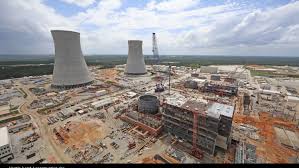The Barakah nuclear-power plant under construction in Abu Dhabi will never attract the attention that the Burj Khalifa skyscraper in neighbouring Dubai does, but it is an engineering feat nonetheless. It is using three times as much concrete as the world’s tallest building, and six times the amount of steel. Remarkably, its first reactor may start producing energy in the first half of this year—on schedule and (its South Korean developers insist) on budget. That would be a towering achievement.
In much of the world, building a nuclear-power plant looks like a terrible business prospect. Two recent additions to the world’s nuclear fleet, in Argentina and America, took 33 and 44 years to erect. Of 55 plants under construction, the Global Nuclear Power database reckons almost two-thirds are behind schedule . The delays lift costs, and make nuclear less competitive with other sources of electricity, such as gas, coal and renewables.
Not one of the two technologies that were supposed to revolutionise the supply of nuclear energy—the European Pressurised Reactor, or EPR, and the AP1000 from America’s Westinghouse—has yet been installed, despite being conceived early this century. In Finland, France and China, all the EPRs under construction are years behind schedule. The main hope for salvaging their reputation—and the nuclear business of EDF, the French utility that owns the technology—is the Hinkley Point C project in Britain, which by now looks a lot like a Hail Mary pass.
Meanwhile, delays with the Westinghouse AP1000 have caused mayhem at Toshiba, its owner. The Japanese firm may announce write-downs in February of up to $6bn on its American nuclear business. As nuclear assets are probably unsellable, it is flogging parts of its core, microchip business instead.
This month, Oregon-based NuScale Power became the first American firm to apply for certification of a small modular reactor (SMR) design with America’s nuclear regulators.
“Clearly the momentum seems to be shifting away from traditional suppliers,” says William Magwood, director-general of the OECD’s Nuclear Energy Agency. Both small and large reactors are required. In places like America and Europe, where electricity demand is growing slowly, there is rising interest in small, flexible ones. In fast-growing markets like China, large nuclear plants make more economic sense.
If the South Koreans succeed with their first foreign nuclear programme in Abu Dhabi, the reason is likely to be consistency. Nuclear accidents such as Three-Mile Island in 1979 and Chernobyl in 1986 caused a long hiatus in nuclear construction in America and Europe. But South Korea has invested in nuclear power for four decades, using its own technology since the 1990s, says Lee Jong-ho, an executive at Korea Electric Power (KEPCO), which leads the consortium building Barakah. It does not suffer from the skills shortages that bedevil nuclear construction in the West.
KEPCO always works with the same, familiar suppliers and construction firms hailing from Korea Inc. By contrast, both the EPR and AP1000, first-of-a-kind technologies with inevitable teething problems, have suffered from being contracted out to global engineering firms. Also, South Korea and China both keep nuclear building costs low through repetition and standardisation, says the World Nuclear Association (WNA), an industry group. It estimates that South Korean capital costs have remained fairly stable in the past 20 years, while they have almost tripled in France and America.
Excerpts The nuclear options: How to build a nuclear-power plant, Economist, Jan. 28 2017, at 57



